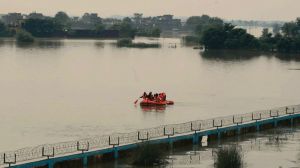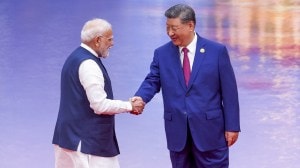What drove up heatwaves this summer in Mumbai? Will monsoon bring flash floods? IMD director explains
Sunil Kamble, the director of India Meteorological Department (Mumbai), said climate change is one reason for Mumbai's unexceptionally hot summer and that there is a 55 per cent probability of above-normal rainfall this monsoon.
 Director of India Meteorological Department, Mumbai Sunil Kamble. (Express Photo)
Director of India Meteorological Department, Mumbai Sunil Kamble. (Express Photo)Extreme temperatures and numerous heatwave days have marked this summer. As Mumbai eagerly awaits the pre-monsoon showers, Sunil Kamble, director of India Meteorological Department (Mumbai) and head of the Regional Meteorological Centre for Western India, spoke to The Indian Express about the factors influencing the frequency of heatwaves and what to expect for the city during the upcoming monsoon. Excerpts:
Mumbai experienced several heatwave days this summer, with at least four or five heatwave days and severe heatwave days recorded in April alone. What caused this sweltering summer?
Sunil Kamble: In the long-range forecast, the IMD had already predicted that we would witness above-normal temperatures during the summers and that the number of heatwave days would be higher. In the month of April, besides four or five heatwaves, Mumbai even recorded the hottest and the second hottest days in the past decade.
The direction of the wind plays a vital role in influencing heatwaves. For Mumbai and Maharashtra, the temperature increases whenever the winds are northerlies and easterlies. Meanwhile, when the winds are westerly, the temperatures remain in the 34-35 degrees Celsius range.
Whenever there are weather systems like high-pressure areas in the Arabian Sea or over Maharashtra, heatwave conditions are more prevalent. Furthermore, one factor responsible for the high temperatures was that we witnessed El Nino during the period.
Can the increased frequency of heatwaves be attributed to climate change?
Sunil Kamble: Yes, climate change is definitely one of the factors impacting temperatures. It is well established that the earth’s temperature has increased by one degree with climate change. Due to climate change, seasonal patterns and norms are changing. We are witnessing extreme weather events such as flash floods and sudden heavy rainfall. This has also impacted temperatures, and as a result, we are experiencing more heatwaves.
Mumbai is witnessing massive concretisation and infrastructural churn. Does this impact the frequency of heatwaves?
Sunil Kamble: Concrete jungles can contribute to higher temperatures and heatwaves. Heat gets trapped for a more extended period of time in these areas, preventing temperatures from falling as quickly as they should. Typically, when temperatures reach 38 degrees, they should decrease within an hour. However, concretisation causes the heat to remain trapped for longer durations, exacerbating the problem.
Moreover, the urban heat island effect is a common phenomenon in urban areas that significantly contributes to higher temperatures. This effect is exacerbated by factors such as the abundance of high-rise buildings and limited green spaces in urban environments.
After experiencing a particularly hot summer, what is the IMD’s forecast for the upcoming monsoon season?
Sunil Kamble: The IMD’s long-term forecast for the monsoon predicts above-normal rainfall. Typically, the normal rainfall range is between 96 to 104 per cent, but this time, the forecast is 106 per cent. Additionally, there is a 55 per cent probability of above-normal rainfall.
Last year, we had the El Nino effect, which has now become neutral. In July, it is likely to become La Nina positive. Whenever we have La Nina, we expect a higher quantum of rain.
Since climate change means increased possibilities of extreme weather events, what does this above-normal rain forecast mean for Mumbai? Is Mumbai likely to witness more flash floods?
Sunil Kamble: Mumbai has a normal average of 2,300 mm of rainfall during the four months of the monsoon. Amidst the forecast of an above-normal monsoon, we are expecting Mumbai to receive more than this average of 2,300 mm of rain this monsoon season. Ideally, Mumbai should get more than 900 mm of rain in July, while in the rest of June, August, and September, we should get at least 500 metres. This year, however, we are expecting more than this average.
We cannot predict extreme weather events right away as they depend on weather conditions during monsoons, such as depressions, cyclonic circulation, and troughs, their locations, and how they will impact our coastal region. All that needs to be monitored, and only then can the forecast for heavy to heavy rainfall events be made.
With Mumbai looking at above-normal rainfall, what measures is the IMD taking to ensure the warnings and forecasts are up to the mark and announced in time?
Sunil Kamble: Currently, we have many automatic weather stations (AWS) across the city that continuously monitor rainfall at 15-minute intervals.
Furthermore, IMD Mumbai has three radars, two located in Mumbai and the other in Goa. These radars provide observations every ten minutes, which are monitored to track weather activity in each area and predict its impact. Based on these observations, we will issue timely nowcast warnings whenever a weather phenomenon is expected.
These nowcast warnings will be communicated to disaster management, railways, and other relevant authorities. Using these radars, we will also issue nowcast warnings to all districts well in advance.







